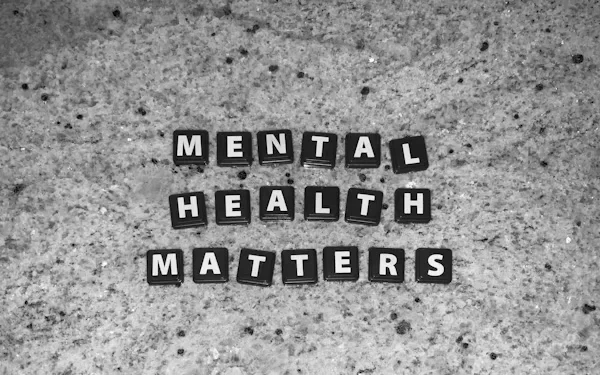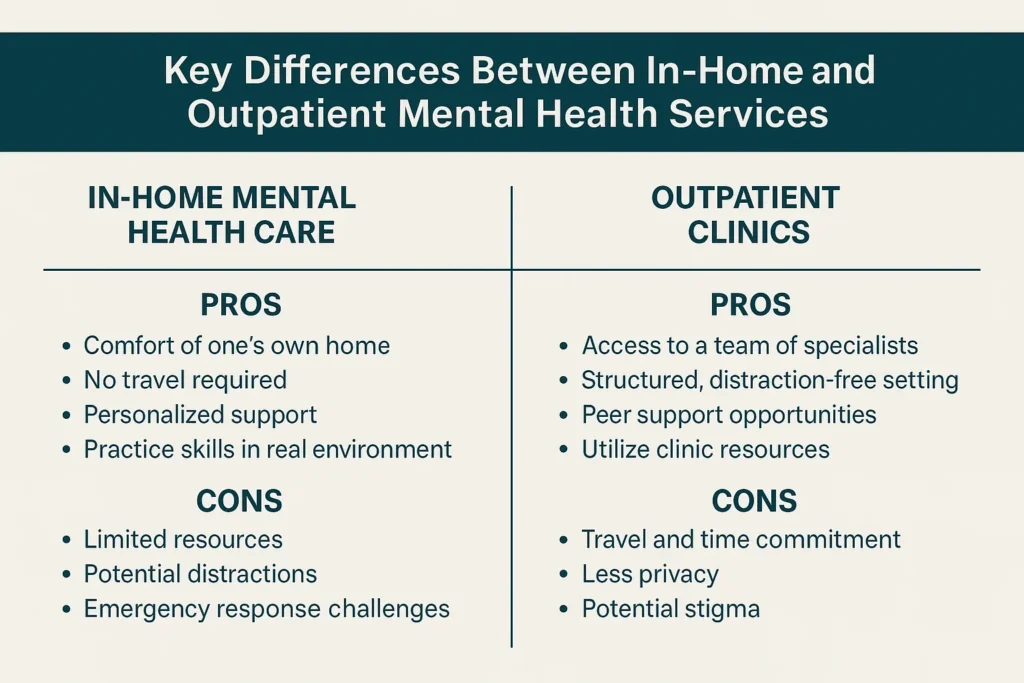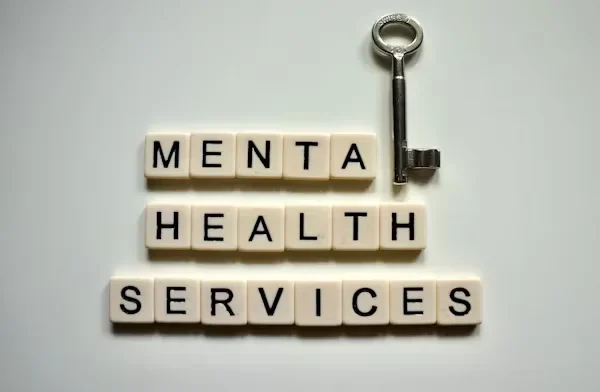Disclaimer: This content is for informational purposes only and does not constitute medical or mental health advice. It is not intended to diagnose, treat, cure, or prevent any mental health condition. Always seek the guidance of a licensed mental health professional or healthcare provider with any questions you may have regarding your mental health or treatment options.
Choosing the right setting is as important as finding the proper support for mental fitness treatment. Two standard options, in-home care and outpatient clinics, offer different benefits depending on your needs, lifestyle, and comfort level. Some people feel safer and more open when receiving care in their own space, while others prefer the structure and resources found in a clinic.
This blog breaks down the pros and cons, helping you understand what each approach offers. Whether you’re exploring options for yourself or a loved one, this comparison will give you clarity to make an informed decision.
Understanding Your Mental Health Treatment Options

Before exploring specific settings, it’s key to understand today’s diverse care models, which offer more personalized behavioral health support than ever.
The Evolution of Mental Health Care Delivery Models
Emotional health treatment has come a long way from the institutional settings of the past. Historically, people with mental illness were often removed from their communities and placed in hospitals with little consideration for their preferences.
Today’s approaches emphasize patient dignity, choice, and recovery in the least restrictive environment possible. Modern treatment models recognize that healing happens best when care aligns with a person’s daily life and unique circumstances, something increasingly reflected in programs based in communities like Laguna Niguel, CA, where personalized support is prioritized.
Technological innovations have further transformed these options, with telehealth creating hybrid models that combine elements both in-home and facility-based care, such as those offered by a Long Term Residential Treatment Center in Laguna Niguel, CA. These blended approaches expand access to care while maintaining the structure and support many individuals need.
Key Differences Between In-Home and Outpatient Mental Health Services

The main difference between in-home and outpatient mental wellness support is the treatment location. In-home care brings services to you, while outpatient care occurs at a clinic or facility. Outpatient programs often include a full team of specialists, whereas home-based providers may work solo or in smaller, coordinated teams.
Insurance tends to favor walk-in care, though coverage for home-based services is improving as their effectiveness becomes clearer. With more flexible options available, understanding both models helps you choose the right fit. Let’s take a closer look at each.
In-Home Mind Health Care: Comprehensive Analysis

Home-based mental fitness services have transformed how care reaches those who might otherwise go without treatment. This approach brings professional support directly into your environment.
Core Components of In-Home Psychiatric Health Services

Most in-home programs provide individual therapy that mirrors what you’d receive in a clinic, using proven methods like cognitive behavioral therapy, dialectical behavior therapy, or psychodynamic approaches. A key advantage is the ability to assess your needs within your natural environment, something that can reveal important details often missed in clinical settings.
This insight supports more tailored treatment plans. Technology also plays a growing role, from digital documentation to virtual reality and video sessions when face-to-face visits aren’t feasible.
Significant Benefits of In-Home Therapy

In-home therapy offers more than just convenience. It provides full privacy, removing the worry of being seen at a clinic, an important factor for many. It also eliminates transportation issues, which is especially helpful for older adults, those with physical limitations, or anyone in areas with poor transit access.
This approach supports real-time learning. You practice coping strategies in the very environment where challenges arise, making it easier to apply new skills consistently in daily life.
Potential Limitations of Inner Well-being Services at Home
While home-based psychiatric care offers personalized support, it also has limitations. Unlike clinics, homes usually lack access to specialized tools like biofeedback or in-depth diagnostic equipment. Distractions can be harder to control; family interruptions or noise may disrupt sessions.
Emergencies are another concern, as clinicians in home settings often operate without the immediate backup that clinics provide. Though highly personal and convenient, in-home care demands careful planning to ensure its effectiveness and safety. Let’s now compare this with outpatient services.
Outpatient Emotional Well-being Clinics: Detailed Evaluation

Outpatient psychiatric health clinics offer structured care while allowing you to maintain your daily life responsibilities. These facilities vary widely in their approach and intensity of services.
Structure and Services of Modern Outpatient Programs

Outpatient care ranges widely, from weekly one-on-one sessions to intensive programs held multiple times per week. Standard outpatient therapy usually involves one or two visits weekly, while intensive options require 3–5 days of structured treatment.
Many centers offer condition-specific tracks for issues like anxiety, trauma, or addiction. Group therapy is a central feature, offering shared experiences and peer support not typically available through home-based treatment alone.
Key Advantages of Outpatient Therapy

Clinic-based care offers several key advantages. One major benefit is access to a team of specialists, psychiatrists, psychologists, social workers, and therapists, who can collaborate in real time. The structured setting also removes everyday distractions, giving you a focused space for healing.
Additionally, outpatient programs often bring people together who share similar experiences, allowing for peer support that can continue to provide encouragement and connection beyond the treatment period.
Notable Drawbacks of Clinic-Based Care
Cognitive health support decisions must account for real-world challenges. Transportation is a major barrier for those without a car, limited access to public transit, or mobility issues. Stigma also plays a role; some hesitate to visit clinics for fear of being seen, especially in smaller communities.
While clinics offer structure, applying learned skills at home can be difficult without added support. Recognizing these limitations helps you decide when institutional care fits best. Next, let’s look at how accessibility factors influence these choices.
Cognitive Health Support: Accessibility Factors to Consider
Therapeutic support accessibility encompasses more than just geographic proximity. Financial, cultural, and logistical factors all influence which treatment setting best serves your needs. With millions of people affected by cognitive health conditions each year, the demand for flexible and accessible care has never been higher. In fact, data from the National Institute of Mental Health shows that nearly one in five adults in the U.S. lives with a mental illness, emphasizing the need for treatment options that meet individuals where they are both physically and emotionally.
Insurance Coverage and Financial Considerations

Insurance coverage for therapeutic support depends on your plan, provider network, and where treatment occurs. Outpatient clinics usually receive broader coverage than in-home services, which may be considered non-standard care. Costs vary; clinic sessions often have predictable rates, while in-home care may include extra travel fees.
When planning, consider both cost and duration. Intensive programs may be more expensive upfront, but can shorten the overall length of treatment.
Geographic and Mobility Impact on Treatment Options
Access to mental wellness support often depends on where you live. Urban areas typically offer more treatment options, while rural communities may require a long travel for even basic services. For those with mobility challenges, in-home care can remove major barriers, no need to navigate parking, stairs, or waiting rooms.
When in-person access isn’t possible, telehealth bridges the gap, offering professional support remotely. These practical realities and clinical needs play a key role in determining which treatment setting fits best. Let’s explore how specific conditions shape this decision.
Decision-Making Framework: Finding Your Ideal Treatment Setting

Comparing in-home and Clinic-based care requires honest self-assessment and professional guidance. This framework helps match your specific situation to the most appropriate treatment environment.
Comprehensive Self-Assessment Questions
Start by assessing the severity and stability of your condition. Intensive outpatient programs are ideal for those with moderate symptoms who need structured support without 24-hour care.
Next, look at your home environment. Does it allow for privacy, safety, and focused healing? If not, outpatient care may offer a better structure. Also factor in logistics: consider travel time, transportation, and how attending appointments might affect your daily responsibilities at work or home.
Collaborative Decision-Making with Professionals

Don’t make this decision on your own. A qualified professional can assess your situation and recommend the right level of care. Be cautious of providers who only push one option without discussing alternatives. Good care starts with a full picture and a personalized plan.
If possible, schedule a short period in your preferred setting with a reassessment. Many begin with outpatient care and shift to home-based support over time. This choice should evolve with your progress.
Personalizing Your Mind Health Care Journey
Finding the right inner well-being treatment setting means balancing care needs with daily life. There’s no one-size-fits-all answer; what works for one person may not work for another. Some benefit from the routine and social interaction of Clinic-based care, while others respond better to the comfort and focus of in-home support. The key is choosing what fits your situation.
FAQs: Mental Wellness Treatment Settings
1. Is inpatient or Clinic-based care better for behavioral health?
The severity of your condition primarily determines this choice. Inpatient programs typically serve those with severe mental illness requiring 24/7 supervision, while outpatient programs better suit those with mild to moderate conditions who can safely function in their daily lives.
2. What is the difference between home therapy and outpatient therapy?
Home therapy serves people with limited mobility or transportation challenges, bringing professional care directly to their living space. Outpatient therapy requires travel to a healthcare clinic or hospital and works best for those with moderate conditions who can reliably attend scheduled appointments.
3. What are the disadvantages of Walk-in care?
Limited access to medical care represents a significant drawback of outpatient settings. Without on-site medical facilities and constant supervision, those with complex needs or requiring continuous monitoring may find Clinic-based care insufficient for their treatment requirements.












